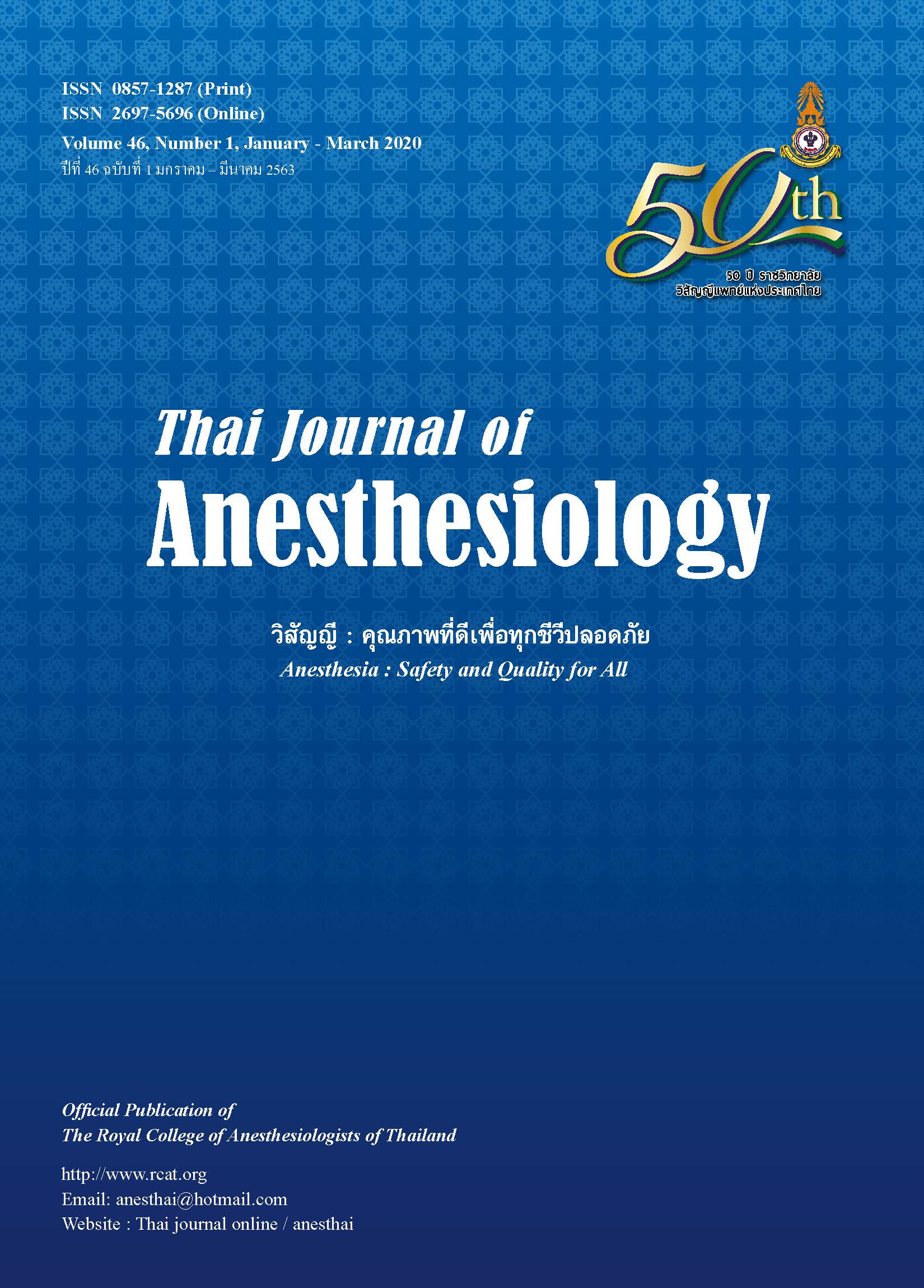การใช้อัลตราซาวด์ในการช่วยระงับความรู้สึกที่ระบบประสาทส่วนกลางที่กระดูก สันหลังส่วนเอว
Main Article Content
บทคัดย่อ
Central neuraxial anesthesia is usually performed
using palpation of surface anatomical landmark at lumbar
region. However, this technique is difficult in some patient
especially those who are obese, pregnant, having previous
spinal surgery or abnormal spinal anatomy. Multiple
attempts at needle placement can increase the incidence
of complications including post dural puncture headache
(PDPH), spinal hematoma, neural injury and patient
discomfort during the procedure. In recent years,
ultrasound has been used to facilitate the neuraxial
anesthesia as a tool to overcome the shortcomings of
conventional approach. Neuraxial ultrasound scans
provide precise identification of vertebral levels and
underlying anatomy as well as prediction the depth of
intrathecal or epidural space. Therefore, it can reduce the
number of puncture attempts and improve success rate
of neuraxial anesthesia.
Article Details
เอกสารอ้างอิง
The intercristal line determined by palpation is not a reliable
anatomical landmark for neuraxial anesthesia. Can J Anaesth
2011;58:262-6.
2. Broadbent CR, Maxwell WB, Ferrie R et al. Ability of
anaesthetists to identify a marked lumbar interspace.
Anaesthesia 2000;55:1122-6.
3. Stiffler KA, Jwayyed S, Wilber ST, Robinson A. The use of
ultrasound to identify pertinent landmarks for lumbar
puncture. AM J Emerg Med 2007;25:331-4.
4. de Seze MP, Sztark F, Janvier G, Joseph PA. Severe and
long-lasting complications of the nerve root and spinal cord
after central neuraxial blockade. Anesth Analg
2007;104:975-9.
5. Auroy Y, Narchi P, Messiah A, Litt L, Rouvier B, Samii K.
Serious complications related to regional anesthesia: results
of a prospective survey in France. Anesthesiology 1997;87:
479-86.
6. Perlas A. Evidence for the use of ultrasound in neuraxial
blocks. Reg Anesth Pain Med 2010; 35(2Suppl): S43-6.
7. Karmakar MK. Ultrasound for central neuraxial blocks. Tech
Reg Anesth Pain Manag 2009;13:161-70.
8. Chin KJ, Perlas A, Chan V. The ultrasound-assisted
paraspinous approach to lumbar neuraxial blockade:
a simplified technique in patients with difficult anatomy. Acta
Anaesthesiol Scand 2015;59:668-73.
9. Chin KJ, Karmakar MK, Peng P. Ultrasonography of the adult
thoracic and lumbar spine for central neuraxial blockade.
Anesthesiology 2011;114:1459-85.
10. Tran D, Kamani AA, Al-Attas E, Lessoway VA, Massey S,
Rohling RN. Single-operator real-time ultrasound-guidance
to aim and insert a lumbar epidural needle. Can J Anaesth
2010;57:313-21.
11. Karmakar MK, Li X, Ho AM, Kwok WH, Chui PT. Real-time
ultrasound-guided paramedian epidural access: evaluation
of a novel in-plane technique. Br J Anaesth 2009;102:845-54.
12. Karmakar MK, Li X, Kwok WH, Ho AM, Ngan Kee WD.
Sonoanatomy relevant for ultrasound-guided central
neuraxial blocks via the paramedian approach in the lumbar
region. Br J Radiol 2012;85:e262-9.
13. Balki M, Lee Y, Halpern S, Carvalho JC. Ultrasound imaging
of the lumbar spine in the transverse plane: the correlation
between estimated and actual depth to the epidural space
in obese parturients. Anesth Analg 2009;108:1876-81.
14. Chin KJ, Ramlogan R, Arzola C, Singh M, Chan V. The utility
of ultrasound imaging in predicting ease of performance of
spinal anesthesia in an orthopedic patient population. Reg
Anesth Pain Med 2013;38:34-8.
15. Chin KJ, Perlas A, Chan V, Brown-Shreves D, Koshkin A,
Vaishnav V. Ultrasound imaging facilitates spinal anesthesia
in adults with difficult surface anatomical landmarks.
Anesthesiology 2011;115:94-101.
16. Chin KJ, Chan V. Ultrasonography as a preoperative
assessment tool: predicting the feasibility of central neuraxial
blockade. Anesth Analg 2010;110:252–3.
17. Li M, Ni X, Xu Z, Shen F, Song Y, Li Q, Liu Z. Ultrasoundassisted
technology versus the conventional landmark
location method in spinal anesthesia for cesarean delivery
in obese parturients: a randomized controlled trial. Anesth
Analg 2019;129:155-61.
18. Sahin T, Balaban O, Sahin L, Solak M, Toker K. A randomized
controlled trial of preinsertion ultrasound guidance for spinal
anaesthesia in pregnancy: outcomes among obese and lean
parturients. J Anesth 2014;28(3):413-9.
19. Shaikh F, Brzezinski J, Alexander S, Arzola C, Carvalho CA,
Beyene J, Sung L. Ultrasound imaging for lumbar punctures
and epidural catheterisations: systematic review and
meta-analysis. BMJ 2013;346;F1720.
20. Grau T, Leipold RW, Conradi R, Martin E, Motsch J. Efficacy
of ultrasound imaging in obstetric epidural anesthesia. J Clin
Anesth 2002;14:169-75.
21. Grau T, Leipold RW, Conradi R, Martin E, Motsch J.
Ultrasound imaging facilitates localization of the epidural
space during combined spinal and epidural anesthesia. Reg
Anesth Pain Med 2001;26:64-7.
22. Perlas A, Chaparro LE, Chin KJ. Lumbar neuraxial ultrasound
for spinal and epidural anaesthesia: a systematic review and
meta-analysis. Reg Anesth Pain Med 2016;41:251-60.
23. Hampl K, Steinfeldt T, Wulf H. Spinal anesthesia revisited:
toxicity of new and old drugs and compounds. Curr Opin
Anaesthesiol 2014; 27:549-55.
24. Belavy D, Sunn N, Lau Q, Robertson T. Absence of neurotoxicity
with perineural injection of ultrasound gels: assessment using
an animal model. BMC Anesthesiol 2013;13:18.


